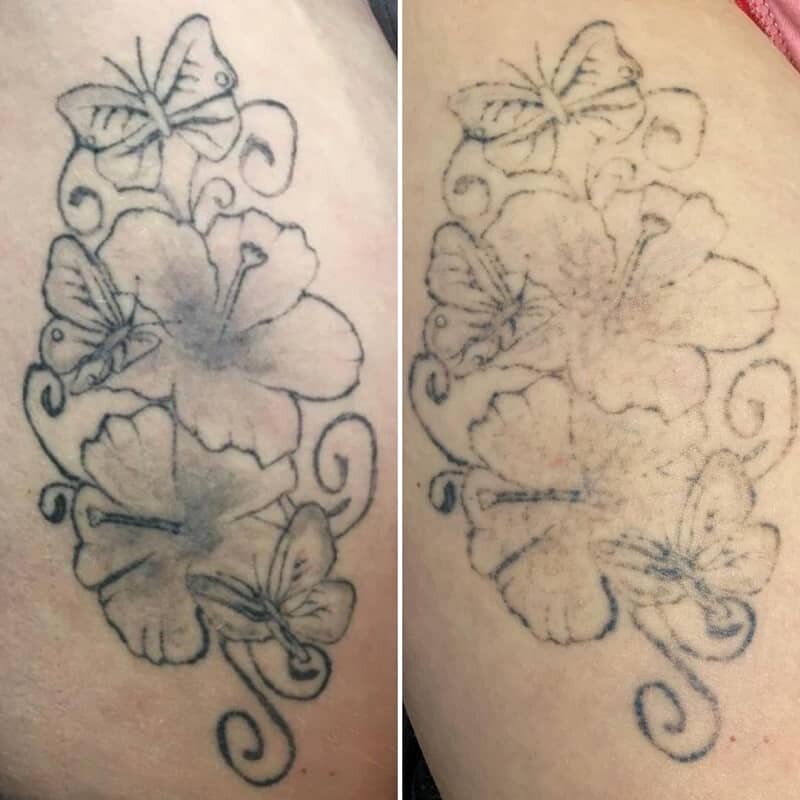
Okay, buckle up, tattoo enthusiasts! Let’s dive into the fascinating world of tiny brushstroke tattoos and see if these delicate works of art can stand the test of time like their bolder, more traditional counterparts.
Do Tiny Brushstroke Tattoos Last As Long As Regular Designs? Unveiling the Longevity Secrets
The allure of tiny brushstroke tattoos is undeniable. They’re minimalist, elegant, and often hold deep personal meaning. But a common question lingers in the minds of potential ink aficionados: do these delicate designs possess the staying power of larger, more conventional tattoos? Let’s explore the factors that influence the longevity of these miniature masterpieces and uncover the truth behind their lasting power.
1. The Allure of the Miniature: Why Tiny Brushstroke Tattoos Are Trending
Before we delve into the nitty-gritty of longevity, let’s acknowledge the captivating appeal of these petite pieces of art. Tiny brushstroke tattoos offer a subtle yet impactful way to express oneself. They’re perfect for those seeking a discreet touch of ink, a meaningful symbol, or simply a beautiful, understated aesthetic. Their delicate nature allows for placement in unique and often hidden spots, adding to their mystique.
2. Ink Density: The Foundation of Tattoo Longevity
The amount of ink deposited into the skin is a critical factor in determining a tattoo’s lifespan. Traditional tattoos, with their bolder lines and filled-in areas, generally have a higher ink density. Tiny brushstroke tattoos, on the other hand, often feature delicate, thin lines and minimal shading. This lower ink density can, in some cases, contribute to faster fading over time.
3. The Artist’s Skill: A Masterstroke in Longevity
The expertise of the tattoo artist plays a pivotal role in the long-term appearance of any tattoo, but it’s especially crucial for tiny brushstroke designs. A skilled artist will understand the nuances of working with fine lines, ensuring proper ink saturation and depth. Inexperienced artists might not deposit enough ink, leading to premature fading or blurring.
4. Placement Matters: Where You Get Inked Impacts Lifespan
The location of your tattoo significantly influences its longevity. Areas prone to friction, such as fingers, hands, and feet, tend to experience faster fading due to constant rubbing against clothing, shoes, or other surfaces. Tiny brushstroke tattoos placed in these high-friction zones may require more frequent touch-ups to maintain their crispness.
5. Sun Exposure: The Silent Enemy of Vibrant Ink
The sun is a notorious foe of tattoos. UV rays break down the ink particles in the skin, causing fading and blurring. Tiny brushstroke tattoos, with their delicate lines, are particularly vulnerable to sun damage. Consistent sun protection is essential to preserving their vibrancy.
6. Skin Type: A Personalized Factor in Tattoo Fading
Our skin type plays a role in how well a tattoo holds up over time. Drier skin may be more prone to fading, while oily skin might cause ink to spread slightly. Understanding your skin type and tailoring your aftercare routine accordingly can help prolong the life of your tiny brushstroke tattoo.
7. Aftercare: The Key to a Lasting Impression
Proper aftercare is paramount for any tattoo, but it’s especially crucial for tiny brushstroke designs. Following your artist’s instructions diligently, keeping the area clean and moisturized, and avoiding excessive sun exposure will significantly impact the tattoo’s longevity.
8. Ink Quality: Investing in Long-Lasting Color
The quality of the ink used also plays a vital role. High-quality inks are formulated to resist fading and maintain their vibrancy for longer. Discuss ink options with your artist and choose those known for their longevity and colorfastness.
9. The Natural Fading Process: An Inevitable Reality
Regardless of the tattoo’s size or design, some degree of fading is inevitable over time. The body’s natural processes, such as cell turnover and the breakdown of ink particles, contribute to this gradual fading. However, with proper care, you can minimize the effects of this natural process.
10. Touch-Ups: A Refreshing Boost for Faded Ink
Touch-ups are a common practice for maintaining the appearance of tattoos, especially those with fine lines or delicate details. Tiny brushstroke tattoos may require more frequent touch-ups than larger, bolder designs to keep their lines crisp and their colors vibrant.
11. Choosing the Right Design: Simplicity vs. Complexity
The complexity of the design can also influence its longevity. Intricate tiny brushstroke tattoos with numerous fine lines and details may be more prone to blurring or fading over time. Simpler designs with fewer lines tend to hold up better.
12. The Color Palette: Light vs. Dark Hues
The colors used in a tattoo can affect its fading rate. Lighter colors, such as pastels and whites, tend to fade faster than darker colors, such as black and blue. Tiny brushstroke tattoos that incorporate lighter hues may require more frequent touch-ups.
13. Lifestyle Factors: How Your Habits Impact Your Ink
Certain lifestyle factors can accelerate tattoo fading. Smoking, excessive alcohol consumption, and poor diet can all negatively impact skin health and contribute to premature fading. Maintaining a healthy lifestyle can help preserve the vibrancy of your tattoo.
14. Realistic Expectations: Embracing the Aging Process
It’s important to have realistic expectations about the longevity of any tattoo, including tiny brushstroke designs. While proper care and maintenance can extend their lifespan, some degree of fading and change is inevitable over time. Embracing the aging process and viewing it as a natural part of the tattoo’s journey can help manage expectations.
15. The Beauty of Imperfection: Embracing the Wabi-Sabi of Tiny Tattoos
Ultimately, the longevity of a tiny brushstroke tattoo is a complex interplay of factors. While they may require more care and attention than larger, bolder designs, their delicate beauty and personal significance make them a worthwhile investment. Embrace the natural fading process and view it as a part of the tattoo’s unique story, a testament to the passage of time and the beauty of imperfection, much like the Japanese concept of Wabi-Sabi.
Conclusion: The Enduring Appeal of Tiny Brushstroke Tattoos
Do tiny brushstroke tattoos last as long as regular designs? The answer is nuanced. While they may require more diligent care and occasional touch-ups, they can still endure beautifully with the right artist, proper aftercare, and a realistic understanding of the factors that influence tattoo longevity. Their subtle elegance and personal meaning make them a captivating choice for those seeking a delicate and meaningful piece of art.
FAQs: Your Burning Questions Answered
1. How often should I moisturize my tiny brushstroke tattoo?
Moisturize your tattoo 2-3 times a day, especially during the initial healing period. Use a fragrance-free, hypoallergenic lotion to keep the skin hydrated and prevent scabbing.
2. Can I use sunscreen on my tattoo?
Absolutely! Sunscreen is crucial for protecting your tattoo from fading. Apply a broad-spectrum sunscreen with an SPF of 30 or higher to your tattoo whenever it’s exposed to the sun.
3. How long does it take for a tiny brushstroke tattoo to fully heal?
The healing process typically takes 2-4 weeks. During this time, avoid soaking the tattoo in water, picking at scabs, and exposing it to direct sunlight.
4. Will my tiny brushstroke tattoo blur over time?
Some blurring is possible, especially with intricate designs or placement in high-friction areas. Proper aftercare and occasional touch-ups can help minimize blurring.
5. What’s the best way to find a skilled artist for a tiny brushstroke tattoo?
Research artists who specialize in fine-line tattoos and have a strong portfolio showcasing their work. Look for artists with experience in creating delicate designs and a thorough understanding of ink saturation and depth.








